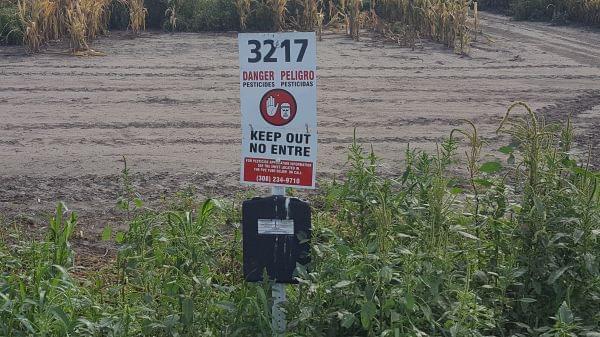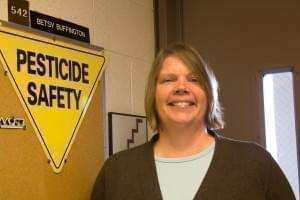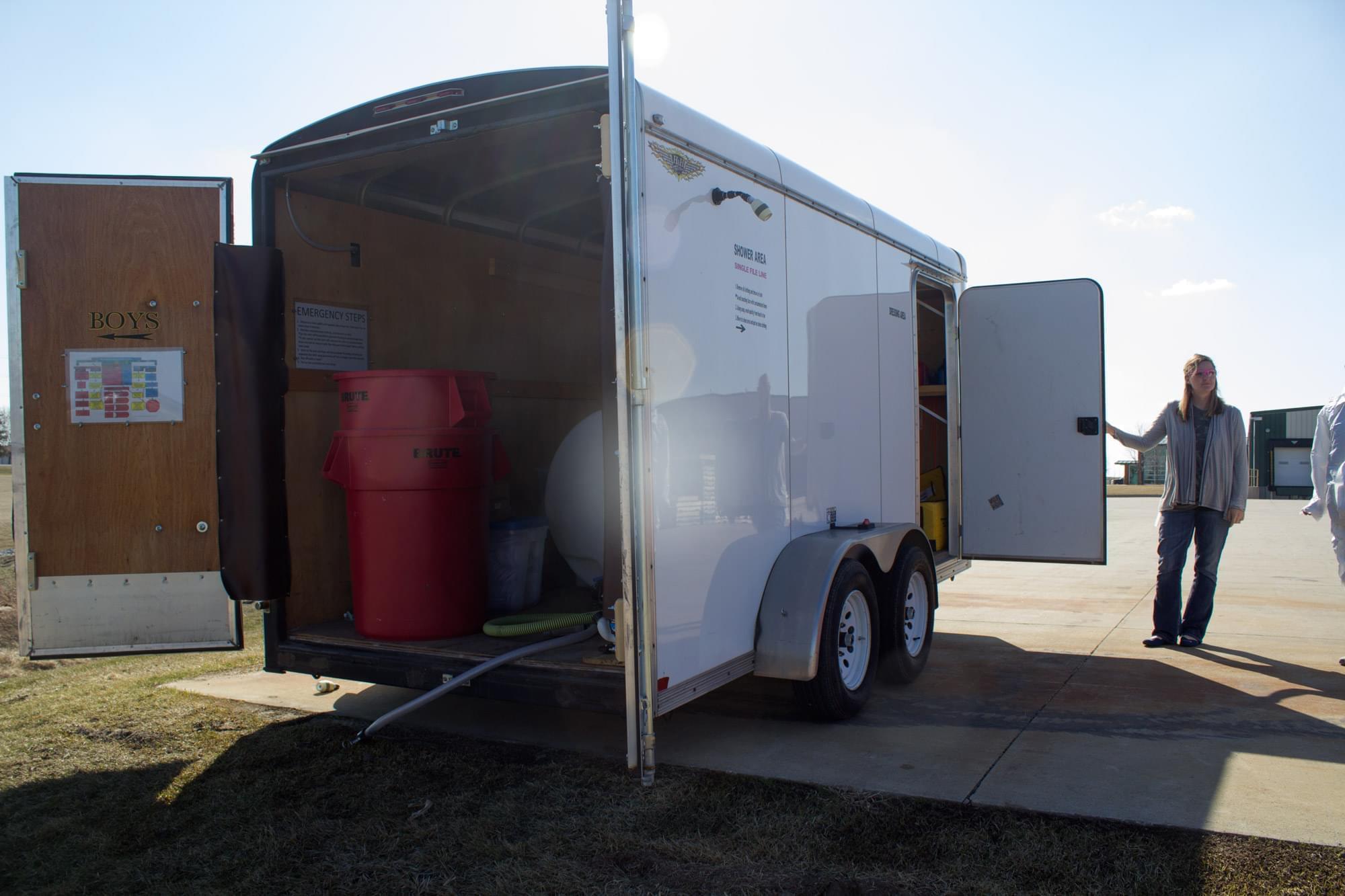Revised Worker Protection Standard Still Leaves Field Crews Vulnerable To Pesticides

An EPA investigation found this sign in a Nebraska field. It provides information about pesticide applications in the area. EPA
More than 2 million people in the U.S. work in or near agriculture fields that are treated with pesticides. The Environmental Protection Agency has strict policies about what those workers need to know about pesticide risks, when they can be in those fields and what they should do if they come into contact with chemicals.
“EPA sets particular criteria of what needs to be included in a training,” said Betsy Buffington, program specialist with the Pesticide Safety Education Program at Iowa State University. “So if an instance occurs, they can look back and know that they're doing it correctly.”
Yet even with recent updates to the decades-old Agricultural Worker Protection Standard (WPS), the EPA has little ability to monitor how well regulations are working, and no way to determine how frequently agricultural pesticides drift onto, or otherwise make contact with, workers.
Smelling poison
When a state agriculture department or the EPA learns of an accident or other pesticide “misuse incident,” as they’re called, it will open an investigation to determine whether adequate training was provided and whether the pesticide applicator followed proper procedures.
That’s what happened after an incident in a corn field in Kearney County, Nebraska, in July 2017. Cellphone video shows a plane flying overhead, turning around and coming back. Then a man describes smelling a poison and says he and his wife were working in the field when the plane began spraying with, he says in Spanish, “No regard for the people below.”
The couple, Jesús Medina and Mildred Martinez of Florida, and another worker, Yasmin Hernandez of Texas, got help from Legal Aid of Nebraska to register a complaint with the Nebraska Department of Agriculture.
On March 12, 2018, Tim Creger, pesticide and fertilizer program manager at the Nebraska Department of Agriculture, emailed the EPA to request the agency look into the matter. Creger noted, in a scanned letter attached to the email, “The NDA believes the enclosed complaints merit serious investigation, since the allegations involved potential harm to human health by a pesticide.”
This correspondence and other records from the EPA, obtained through a Freedom of Information Act request, show the EPA conducted an investigation that stretched out over a year. In that time, the workers, their employer, the seed corn company that contracted with their employer, the pilot and the aerial application company he worked for all received visits and/or phone calls from the EPA investigator.
Ultimately, according to EPA documents, the seed corn company and the employment contractor were found to have complied with the WPS. Additionally, the flying service and pilot kept the appropriate records showing the types and amounts of pesticides used. The EPA investigator concluded these were in accordance with the products’ labels and that the wind at the time of the application was below the maximum permitted.
The lawyer who helped the field workers bring their complaint declined to be interviewed for this story.
A stronger standard?
The EPA established the WPS in 1974 and revised it in the 1980s and 1990s. In 2014, the EPA revamped it again to ensure that employers provide adequate information about pesticide safety (in a language the workers understand) and that they have on hand ample clean water and supplies for people to wash up if they are exposed to chemicals.
The last of the most recent changes went into effect last year.
Workers, as they did in the Nebraska incident, must view EPA-approved training before they begin field work.

Iowa State University trains thousands of pesticide applicators every year. Betsy Buffinton is a program specialist with the Pesticide Safety Education Program.
“It’s a training that is required of workers, the people who work around pesticides but not really with pesticides,” Iowa State’s Buffington said. “A worker training is basically, this is where we keep our water resources if you need to wash after you're around pesticides. It talks about work clothes: long pants, close-toed shoes, long-sleeved shirt, even if it's hot out.”
She said the burden is on employers to ensure their employees understand the rules.
“If you hire someone seasonally, they come in, they may not know to not enter as a pesticide application is taking place,” Buffington said. “And so it's basically a protection against them.”
EPA recognizes shortcomings
The Nebraska incident and others demonstrate that accidents continue to occur, despite the tighter Worker Protection Standard. What’s more, an internal review by the EPA’s Office of Inspector General in 2018 found that the Worker Protection Standard falls short in some areas:
- The EPA does not have the ability to collect agricultural pesticide exposure incident data to measure the impact of the revised WPS rule among target populations.
- The agency relies on information assessed during pesticide re-evaluations and from voluntary reporting databases.
- The EPA is working on improving its Incident Data System, but the agency stated that the improvements will not enable the collection of additional occupational exposure data.
In February, the EPA’s Office of Chemical Safety and Pollution Prevention responded, saying it would gather incident reports from a federal monitoring program that is underfunded and from the National Pesticide Information Center, which provides the office “with reports of agricultural workers’ exposure to pesticides.” But that information comes from the voluntary databases referenced in the Officer of Inspector General report.
Industry regulating itself
Without the fear or threat of close scrutiny by state or federal officials, some agricultural employers take it upon themselves to do more than the minimum to protect their employees. But even additional preventive measures aren’t always enough.

Bayer Crop Science site lead Shannon Boehm holds open one door of a shower trailer, formally called a decontamination unit.
“As an industry, there's so many different things to chase as far as, Where are the people who are flying the planes? Where are they coming from? How could we communicate with them to help them know where we're at?” said Shannon Boehm, site lead for Bayer Crop Science in Huxley, Iowa, which hires crews to detassel corn.
She said the company contacts local co-ops and flying services to let them know where they will have crews each day. It also stations emergency shower trailers near all of its fields during the season, just in case workers get sprayed because, Boehm said, new companies can send aerial applicators in from other states at any time and she'd have no way of knowing.
“They don't really have to check in with anybody to be in the area,” Boehm said. “So that's the problem, where would we even go to let them know?”
That’s a question the most recent version of the Worker Protection Standard doesn’t even try to answer.
In Part 1 of our series, read more about the risks of aerial pesticide application. Part 3 of our series, which will publish May 15, looks at how states with legal marijuana are navigating pesticide use and safety while it remains illegal at the national level.
Follow Amy on Twitter: @AgAmyinAmes
Editor's note: this story has been updated to correct Betsy Buffington's title. She is a program specialist.

